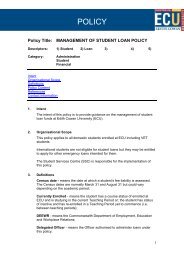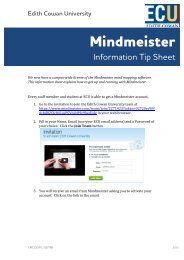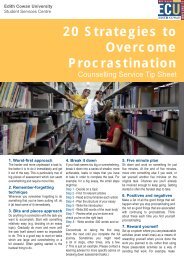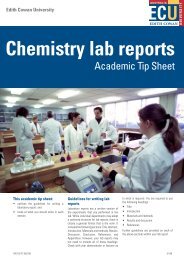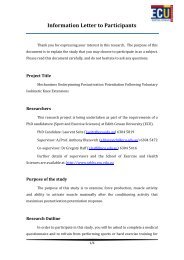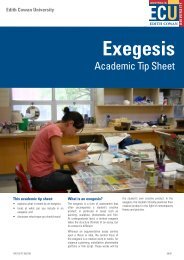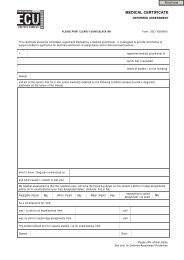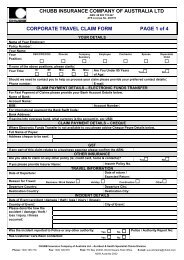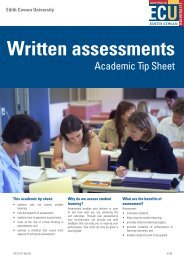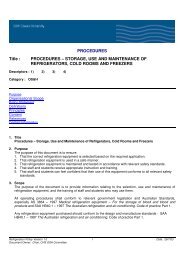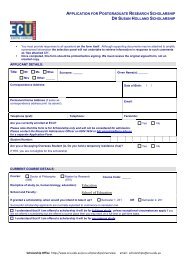Benchmarking: A Literature Review - ECU | Sign In : Portals - Edith ...
Benchmarking: A Literature Review - ECU | Sign In : Portals - Edith ...
Benchmarking: A Literature Review - ECU | Sign In : Portals - Edith ...
You also want an ePaper? Increase the reach of your titles
YUMPU automatically turns print PDFs into web optimized ePapers that Google loves.
enchmarking undergraduate courses: curriculum, assessment issues, student learning outcomes, programresources, student development, faculty characteristics, program climate, and administrative support (Dunn,et al., 2007).The <strong>Benchmarking</strong> Portfolio (Oliver, 2011b) is a 360-degree, evidence-based approach with four phases:1. Determine capabilities: determine the capabilities that count for early professional success;2. Map inputs: when, where and how those capabilities are developed and assessed in the course asdemonstrated by reflective (qualitative) and numerical (quantitative) evidence;3. Evaluate outcomes: engage with partners (internal and external stakeholders); and,4. Plan enhancements.Many institutions use a template for reporting that reflects the priorities and values (Dunn, et al., 2007).Alignment between curriculum, teaching and assessment as the conceptual framework for self-evaluation ispivotal (Henderson-Smart, et al., 2006), while content, instruction, assessment and equity and diversity wereconsidered as curriculum (Ellibee & Mason, 1997).The Australasian Council on Open, Distance and e-Learning (ACODE) provide a benchmarking plan withscoping statements, good practice statements, and performance indicators and measures for eight areas:1. <strong>In</strong>stitution policy and governance for technology supported learning and teaching;2. Planning for and quality improvement of the integration of technologies for learning and teaching;3. <strong>In</strong>formation technology infrastructure to support learning and teaching;4. Pedagogical application of information and communication technology;5. Professional/staff development for effective use of technologies for learning and teaching;6. Staff support for the use of technologies for learning and teaching;7. Student training for the effective use of technologies for learning; and,8. Student support for the use of technologies for learning.(Australasian Council on Open Distance and e-Learning, 2007)Examples of <strong>Benchmarking</strong> of Courses1. The speech pathology discipline in Australia and New Zealand identified a valid framework of studentlearning outcomes, threshold standards and effective strategies to benchmark against these standards thatresulted in the development of a valid and reliable competency-based assessment tool called COMPASS ®(McAllister et al., 2011). Competencies and level of achievement required of graduate speech pathologistsare the seven Speech Pathology Competency-Based Occupational Standards – Entry Level (referred to asCBOS). Reasoning, Lifelong Learning, Communication and Professionalism were also identified by theprofession as important professional capacities (McAllister, et al., 2011).2. Communications discipline course leaders from three universities benchmarked their journalismundergraduate courses starting with a review of literature identifying streams of literature over the pastfifteen years (Oliver, Bethell, Fernanadez, Harrison, & Breit, 2011).3. A benchmarking project on archaeology courses in Australian universities paid attention to criteriadeveloped to assess students’ demonstrated understanding and skills, and the teaching and learningenvironment (Teaching and Learning Centre, 2008).4. A project to benchmark assessment between three Australian universities was carefully scoped through acollaborative process checking that it was achievable and within the timeframe. The project resulted in aclear, robust framework for benchmarking assessment (Booth, et al., 2011). Statements of good practice inassessment were developed as one part of a Teaching Quality <strong>In</strong>dicators ALTC project (Davies, 2009). Theformat was derived from the ACODE <strong>Benchmarking</strong> Framework (Australasian Council on Open Distance ande-Learning, 2007). All three universities used self-reviews to facilitate discussion and reflection as well as tocollect and evaluate data. Yet each university adopted different methodologies for the self-review (Booth, etal., 2011).8<strong>Benchmarking</strong>: A <strong>Literature</strong> <strong>Review</strong>



